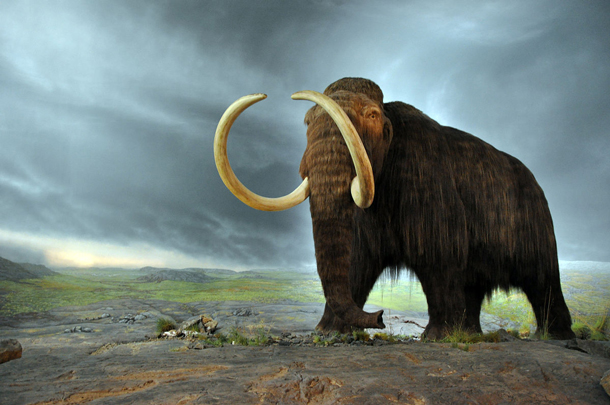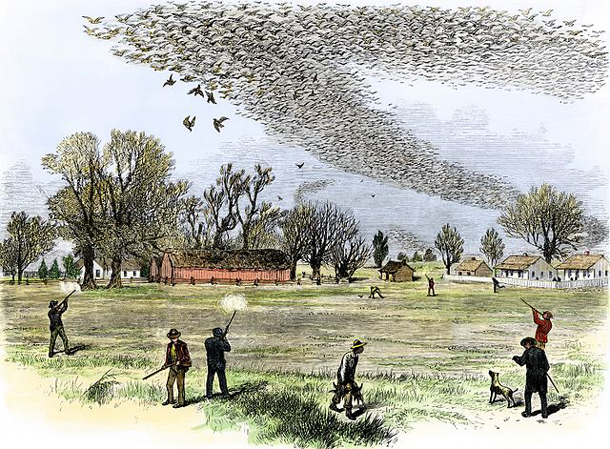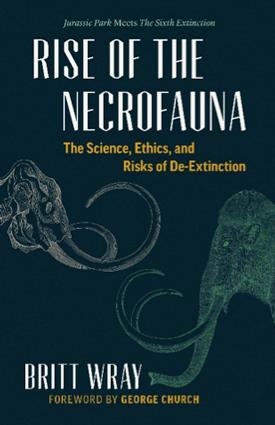Rise of the Necrofauna
Air Date: Week of October 13, 2017

Researchers at Harvard University are currently editing Asian Elephant genomes to make Woolly Mammoth-like embryos. (Photo: Thomas Quine, Flickr CC BY 2.0)
Bringing extinct species like dinosaurs back from the evolutionary graveyard has long been a science fiction story. But with new gene editing technologies, cloning and careful selective breeding, this dream of de-extinction could soon be a reality. In her new book, Rise of the Necrofauna, science writer Britt Wray looks into real-life efforts to bring back lost species and what recreating an extinct creature would entail. She discussed with Living on Earth’s Helen Palmer the scientific, ethical, and cultural challenges of emerging de-extinction technologies and what conquering extinction could mean for conservation in the future.
Transcript
CURWOOD: It’s Living on Earth, I’m Steve Curwood.
Species are currently disappearing at such a rate that the loss rivals the great extinction events of the past, such as the one that killed off the dinosaurs some 65 million years ago. Fiction has given us an antidote, of course. Novelist Michael Crichton portrayed scientists able to use DNA from fossils and bring dinosaurs back to life in Jurassic Park. And now some recent scientific advances have shifted the idea of bringing back the woolly mammoth or the passenger pigeon from the realm of science fiction into something more like fact.
Still, that doesn’t get rid of huge obstacles that stand in the way of de-extinction, and science writer Britt Wray has chronicled technical, ethical, and legal problems in her new book, Rise of the Necrofauna,. She spoke with Living on Earth’s Helen Palmer.
PALMER: Now, Britt Wray, your new book is called Rise of the Necrofauna. Why did you choose that term...necrofauna?
WRAY: I get a lot of puzzled looks about that term. It's a funny one. I first heard it used by a futurist by the name of Alex Steffen, and he was using it to describe a possibility with de-extinction that we might just pursue this recreation of proxies, of extinct species, in order to make humans feel good and produce what he called “charismatic necrofauna”, so extinct animals that we prefer to see because they're majestic, cute, cuddly, beautiful, something inspiring to look at and be around rather than actually paying attention to a variety of other species that we could have chosen instead of candidates for de-extinction. So, it was a bit of a tongue in cheek choice to call it Rise of the Necrofauna. It's a bit ominous sounding, but it does raise this question, you know. If forms of extinct animals can be brought back to life, one of the big ethical issues that we need to contend with is how we make the choice around which ones to select for de-extinction projects.
PALMER: Obviously, it's an interesting challenge, this idea of the de-extincting species, but why do scientists really want to do it in the first place?

The extinct passenger pigeon, once abundant across North America, is the subject of de-extinction efforts. (Photo: Smith Bennett, Wikimedia Commons)
WRAY: The main reason that people who are advocates of de-extinction or even the scientists working on it put forth for why this would be a good idea is that there are ecosystems that have changed dramatically since particular keystone species, the really prominent species that had an important functional role disappeared, and the idea is that, if we could create new animals that have reconstituted genes from extinct species in them that would allow them to carry out the roles of those extinct species, maybe their being put back in those environments that have become ecologically de-pauperate, maybe that could be improved by having some kind of acting species that could carry out those lost roles.
PALMER: So, what kind of species are at the top of the list?
WRAY: Well, the ones that people are working on include the passenger pigeon, the woolly mammoth, the gastric brooding frog, aurochs, the list goes on. It's still relatively fringe. There aren't tons and tons of projects, but there's a handful of a variety of different species that people have either tried and stopped or are currently looking at doing.
PALMER: So, what kind of techniques would you use to actually recreate an extinct animal?
WRAY: One is back breeding. We can think of the way that humans have bred dogs from wolves by selecting traits in wolves that they found desirable and crossing them together over multiple generations to arrive at a variety of dog breeds that we now know and love, but it can also work to breed a form of animal that is no longer here. So, the ancestor of all of today's cattle is something called the “aurochs”, and we know what they looked like, we know what their horn shape was, the coloration, all sorts of characteristics we can then select for in living cattle breeds that we cross over successive generations until we get something that looks pretty much like the original, extinct ancestor.
Then, there's also cloning. So, many people are familiar with the most famous adult animal clone we've had on Earth, Dolly the sheep, who was created by a process called somatic cell nuclear transfer, and that requires a cell from the animal that you want to clone that is whole and intact. The thing with an extinct species is that you'd be using preserved tissue from an animal that is no longer here, but that has been frozen immediately after it died, and when you're talking about a lot of animals that have been gone for a long time like the woolly mammoth, for example, it's really difficult to find a perfectly intact a woolly mammoth cell that has that nice nuclear genome all bound up that makes cloning possible. And so, then you have to look in places like Siberia and pull chunks of mammoth tissue out of the permafrost and see if you can find anything that's intact, and so far that quest is still on.
PALMER: There's back breeding, there is cloning, there is finding extinct DNA and trying to revive it. Any other techniques they're using?
WRAY: So, the last part that I didn't talk about yet, the last approach that people are using, is gene editing. So when you don't have a full intact genome inside a nicely preserved nucleus of an extinct animal, you can potentially edit specific pieces of the extinct animals DNA into an animal that most closely resembles it that is living. So, in the case of the woolly mammoth, that's the Asian elephant. And so you use the living animal the genome as the base template that you then edit to insert the genes of interest to basically then tinker and cobble together a proxy of the extinct animal in the genome of the living animal.
So, you can introduce the gene that gave it the thick shaggy iconic hair or fatty insulating skin or the ability to bind and release oxygen in its blood at cold temperatures which elephants can't currently do. So then you end up essentially with a hairy elephant that can live and act potentially like the woolly mammoth you want to create.

Back breeding, a process sometimes used breed dogs that look like their ancestors, is a popular form of genetic modification in de-extinction efforts. (Photo: Albert Herring, Wikimedia Commons)
PALMER: Now, obviously the new gene editing technique CRISPR, which has received a huge amount of press because it's so capable of fixing genes in humans that are defective, has given a new lease of life to this as a possibility, this idea of recreating, say, a mammoth with an Asian elephant as a mother.
WRAY: CRISPR is the blockbuster tool of a variety of de-extinction projects, and with the woolly mammoth project, for example, at Harvard there are already a variety of dishes full of Asian elephant cells that have been edited to have woolly mammoth genes inserted into the cells using CRISPR, and the idea that they're testing out, what is the effect of putting a red hair or a shaggier hair gene into elephant cells, what does that cause in terms of cellular change? And eventually, once they understand that for all the traits that they want to edit in, they plan to make all of the edits simultaneously in a master cell.
PALMER: Given the cost and the difficulty of actually creating animals by any of these techniques you've talked about, we may be able to get one, two, five, but if you want to reintroduce them to a landscape, you'll need hundreds. I mean, that seems implausible. So, is what we're looking at a kind of like quasi-woolly mammoth in a zoo, the one, the only one there is?
WRAY: For a time, yes. If de-extinction is successful in terms of producing individual animals that fit the definition of what you call the revival, you know, let's say a hairy elephant that can live in the north. It is going to be that you don't get a full species right out of the gate. It's simply not possible, so you need to build that up and you also need to be able to study their welfare. You can't simply create them in a lab and let them loose in the Yukon or northern Siberia. So yes, captivity is part of the formula here.
PALMER: Wouldn't we be better off trying to preserve the actual threatened species we've got at the moment?
WRAY: Personally, I definitely think so. However, there are certain things about de-extinction that may be able to transfer over into helping endangered species. The researchers at Harvard in George Church's lab who are working on the woolly mammoth resurrection are also now working on creating a CRISPR-based system to help elephants that are dying from EEHV which is a herpes virus which is wiping them out in captivity and in the wild. So, it was these researchers while working on the mammoth project needing to look into Asian elephant biology for that project that led them to discover this herpes problem, and they realized, “Oh the tools we're using for de-extinction might also be able to create a gene editing system that detects the herpes virus and disable that, cuts it up, chops it with CRISPR before it actually infects the elephants.”

Rise of the Necrofauna looks at the scientific, ethical, financial, ecological, and legal aspects of modern de-extinction efforts. (Photo: courtesy of Elizabeth Shreve)
PALMER: Well, that sounds entirely plausible, and then you look at say a species like the cheetah, which has a fantastic genetic bottleneck. They, too, are in danger because of their genetic similarity. So, you know, maybe indeed you could help a species like that.
WRAY: That's a great point, and that is a key way that these tools are increasingly being used for transgenic conservation or synthetic biology conservation, whatever you want to call it. We're realizing that it's not just about taking extinct genes and turning them into a new form of a genome, but we can take any genes, you know, living or extinct and apply them into a variety of organismal genomes.
So black-footed ferrets are another species that people are looking at here because they have such low genetic diversity. Their founding population had very few individuals of the ones that are around today, and so they're really inbred, and that causes all sorts of problems for them, but if you can take genetic material from long dead ferrets that had more genetic diversity before they went through a population bottleneck which have been stored in cryogenic freezers, and you can edit that diversity into the living ferret gene pool, can we not then help the existing ferrets and increase their biodiversity that way.
PALMER: Of course, there is another sort of moral hazard which is that, if you could indeed bring animals back from the dead, if you managed to recreate these animals, then there's so much less requirement to actually preserve the ones we've got in the threatened ecosystems at the moment. So why would you not cut down an old growth forest to save the spotted owl or whatever because if the spotted owl goes you can always bring it back in ten years, say?
WRAY: I believe that one of the worst things that could come from de-extinction is the public becoming familiar with an idea that we could bring back an extinct species at a more opportune future time and let them go extinct now while it's more difficult to keep them alive or when we want to use their habitat or something to that effect because it's not the case. There is no such thing as resurrecting an extinct species. You are always creating a new version of a species that has a lot of the genes and traits and characteristics potentially of the extinct species, but you're creating something novel and you're hybridizing.
PALMER: Your book is very wide ranging in terms of all the things. It looks at the ethics of it, looks at the moral questions of it, it looks at the feasibility, but you haven't ended up with any firm recommendations. How do you feel about it yourself?
WRAY: I wrote the book in an exploratory way that wanted to give the reader a 360 view as much as is possible of what the pros and the cons and the gray areas might be around this so that they could make up their mind for themselves without me feeding them a narrative that I wanted to be their narrative in terms of the take home final message of, is this right or wrong?

Britt Wray is a journalist and author of the new book, Rise of the Necrofauna. (Photo: courtesy of Arden Wray)
However, I do, of course, have my own feelings, and I do not think that de-extinction is a solution to the environmental issues that we are facing. But, I do see that aspects of it can move over to benefit a variety of endangered species and that that is where we need to focus our efforts.
There are lots of interesting and mundane ways that we might be able to use it that takes it off the podium of “gee whiz flashy science.” Let's talk about Jurastic Park. And there might be some fantastic merits that are brought forth from particular de-extinction projects but I think the real value of this is in encapsulated in how we then take what we're learning from these explorations in de-extinction and apply them to the species that we need to save now.
PALMER: Do you have a species that you would - assuming it were possible, assuming it were ethical, assuming we could get over the hurdles - is there a species that you would like to see de-extincted, that you would like to see brought back?
WRAY: Well, if we can stretch our definition of de-extinction to include those that are functionally extinct, and by that I mean extinct in the wild, then I would say I am 100 percent rooting for the northern white rhino. There are three individuals living, the last three of its kind on the equator in a conservancy called Ol Pejeta in Kenya. It's a patriarch, his name is Sudan, and then his daughter and granddaughter, Najin and Fatu and then that’s it, so they are related, they're so closely tied that if they were to procreate they would be so badly inbred that that wouldn't be good for the future of the species, but they also have a variety of issues with their their own biology that make them infertile. And so these are beautiful important creatures with a unique ecological role to play that humans have hunted out of their habitat and I think would be a fantastic use of de-extinction because they are essentially a dead species walking otherwise.
CURWOOD: Britt Wray’s new book is called Rise of the Necrofauna. She spoke with Living on Earth’s Helen Palmer.
Links
NYTimes: “We Might Soon Resurrect Extinct Species. Is It Worth the Cost?”
Smithsonian: “These Are the Extinct Animals We Can, and Should, Resurrect”
Living on Earth wants to hear from you!
Living on Earth
62 Calef Highway, Suite 212
Lee, NH 03861
Telephone: 617-287-4121
E-mail: comments@loe.org
Newsletter [Click here]
Donate to Living on Earth!
Living on Earth is an independent media program and relies entirely on contributions from listeners and institutions supporting public service. Please donate now to preserve an independent environmental voice.
NewsletterLiving on Earth offers a weekly delivery of the show's rundown to your mailbox. Sign up for our newsletter today!
 Sailors For The Sea: Be the change you want to sea.
Sailors For The Sea: Be the change you want to sea.
 The Grantham Foundation for the Protection of the Environment: Committed to protecting and improving the health of the global environment.
The Grantham Foundation for the Protection of the Environment: Committed to protecting and improving the health of the global environment.
 Contribute to Living on Earth and receive, as our gift to you, an archival print of one of Mark Seth Lender's extraordinary wildlife photographs. Follow the link to see Mark's current collection of photographs.
Contribute to Living on Earth and receive, as our gift to you, an archival print of one of Mark Seth Lender's extraordinary wildlife photographs. Follow the link to see Mark's current collection of photographs.
 Buy a signed copy of Mark Seth Lender's book Smeagull the Seagull & support Living on Earth
Buy a signed copy of Mark Seth Lender's book Smeagull the Seagull & support Living on Earth

